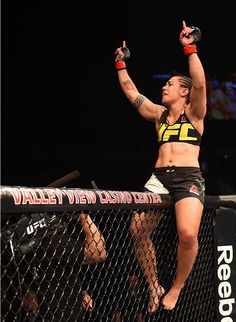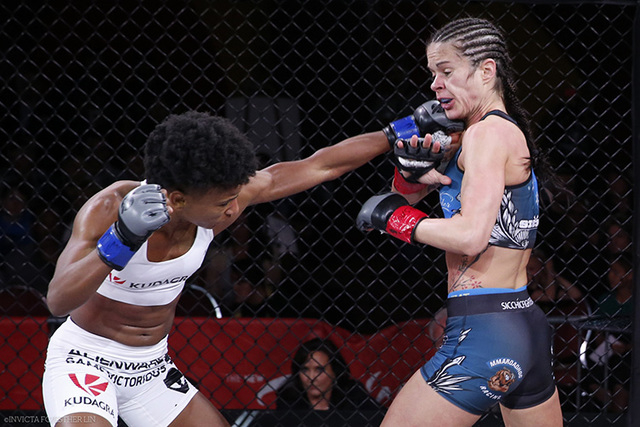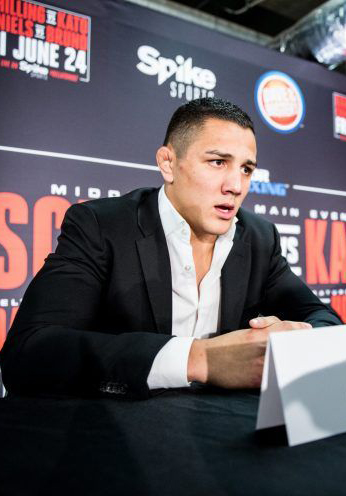This Saturday at UFC Fight Night 104 we have another matchup between two streaking fighters. The B side is Angela “OverKill” Hill, a member of the first all-women’s season of The Ultimate Fighter and a former UFC strawweight who was exiled after a one-sided loss to Rose Namajunas. Hill then rebuilt herself inside the Invicta Fighting Championships, refining her footwork, positioning, defensive awareness, and offensive efficiency. She developed an identity as fighter; these skills were equally distributed across the board in her striking, wrestling, and grappling. This growth paid big dividends, as she won three fights in a row on the way to winning an Invicta strawweight championship and being invited back into the Octagon.
Hill’s opponent — and the focus of this article — is Jessica Andrade, another resurgent fighter, one whose path to elite status was not the result of rebuilding herself outside of the glare of the lights of the big show. No, her renaissance is directly tied to a change in weight classes, where in about a year to a year and a half’s time she has gone from journeywoman to possible title challenger. Today we will discuss Andrade, the impact changing divisions has had on her career, and the impact on her matchup with Hill this Saturday night.
Andrade started out in the UFC as a bantamweight. Her results in the division were mixed at best — she had seven fights in the Octagon, winning four fights and losing three. When glancing at her record, it doesn’t look bad; in fact it looks better than other women currently at bantamweight (Lauren Murphy, Cat Zingano, and Jessica Eye to name a few). But upon closer examination you notice three of her four wins are against fighters who not only aren’t in the UFC anymore (Sarah Moras, Larissa Pacheco, and Rosie Sexton), but only one of which has an actual win in the Octagon (Moras). Andrade’s only other win was a disputed split decision win over Raquel Pennington; when you factor those things in, her wins carry a lot less weight.
Now let’s look at the losses. We have established that against a certain class of athlete (technical and physical) Andrade is a force. However, once you raise that level, the bantamweight incarnation of Andrade is surprisingly ordinary. Liz Carmouche outworked and physically dominated her. Marion Reneau, another superior athlete in regards to size, speed, strength, and power, quickly finished her. And then we have Pennington, who will never be mistaken for a top end athlete, but was more durable, more physical, and more technical than other fighters Andrade beat. Pennington decisively beat her by submission in the second round of their rematch, a fight that was exciting, but further exposed her limitations. Andrade has a full skill set but isn’t particularly nuanced in any one area; a lot of her success is based on her physicality, strength, and athleticism; once those advantages aren’t there, the holes in her game become highlighted. Her lack of defensive responsibility on the ground. Her lack of clean or precise defensive AND offensive footwork. Her striking style (which I refer to as educated brawling), which is fine when you can physically dominate, but is a complete liability when your power and strength can’t dictate terms of engagement.
This is what precipitated her drop to strawweight, the fact that when her physical tools aren’t a factor, her technical skills aren’t big enough difference makers, at least not on the plus side. So a change in divisions makes her physicality, her durability, her strength, and her power a factor. The technical holes are still there, but the aforementioned attributes have limited the impact those technical shortcomings have on the results of her fights. As I often say, people move up a weight class because they figure their skill and smarts will essentially outweigh any physical advantage opponents may have; people drop weight because they feel their physical advantages will outweigh any technical advantage their opponents may have. If you listen to enough interviews by fighters doing this, you will notice that very common theme. Andrade is no different, and in her last two fights she has essentially run over her opponents.
Jessica Penne and Joanne Calderwood are both fighters that are very skilled and competent, but the lack of physical ability (in the case of Penne) and the lack of the right kind of physical ability (in the case of Calderwood) led to one-sided losses by two very good strawweight fighters. Penne’s issue is one that was predictable and historical based on both her runs in Invicta, on TUF, and in the UFC; she is tough, skilled, and experienced, but lacking in physical durability, power, and overall athleticism. On top of that she is in fact an atomweight who moved up to 115 pounds for the opportunity to fight in the Octagon. Calderwood, on the other hand, is a strawweight, and a big one at that; having power, physicality, and durability which highlights the majority of the wins she has had in Invicta and the UFC. More times than not, that is a clear path to victory for her, as it often can make up for her historically slow starts, suspect defense, and lack of top-end athleticism. But when facing a strawweight like Andrade,who also has each of those attributes and is a) a fast starter and b) used to plying that trade against women fighting two divisions higher than the one she is currently competing, that won’t be enough for Calderwood, and it wasn’t.
This brings us to Hill. At 6-2 she isn’t a veteran who has seen and done it all; that’s not what makes her dangerous. What makes Angela Hill dangerous is her athleticism — it’s the right kind of athleticism and it has been bolstered by an improvement on the fundamentals allows her to maximize those advantages. Hill has always been a fighter blessed with explosiveness, agility, mobility, and power, as well as natural hand and foot speed. All these things create problems for a fighter like Andrade, whose advantages lie in physical strength, durability, aggression, and power, but is someone who doesn’t focus on the finer points of mixed martial arts (i.e. footwork, feints, clean striking, combination striking or defense and counters). Earlier versions of Hill didn’t have maturity in her fight game and could easily get trapped, roughed up, and beaten up. This version has defensive footwork, ability, willingness to actively counter, and most importantly, a dedication to defensive wrestling, which has freed up her offensive repertoire in a way that the previous lack of balance in her game didn’t allow.
Andrade is a favorite, and rightfully so. She is the one who stayed in the UFC and has winning records in two weight classes. She is a big, strong, physical, and skilled fighter, but one who, much like a Julianna Peña, is defined by her attributes and aggression more than any individual skill or combination of skills. This is directly related to the size advantages she has as a result of dropping divisions. Angela Hill doesn’t have the experience or pedigree that says she wins this fight, but she has the physical tools and the technical skills to win, which Andrade’s previous opponents didn’t. Andrade is going to have to fight to win this, because for the first time in a long time, she has an opponent who can make her pay for things she isn’t good at and make her work to be effective doing the things she is good at. Saturday night we find out how far both have come and how far both can go in their second runs in the UFC.

UFC Fight Night 104: Bermudez vs. Korean Zombie takes place February 4, 2017 at Toyota Center in Houston, Texas.
Click the stars to rate how good you think UFC Fight Night 104 will be.
*********







